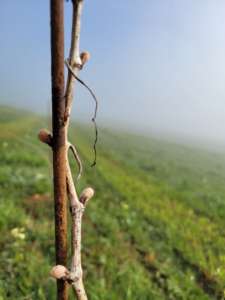This may be the only time a reference to The Wizard of Oz appears in this blog. Remember the scene where Dorothy opens the farmhouse door and the drab Kansas gray gives way to the vivid, vibrant green hues of the magical Land of Oz? That, my friends, is bud break in the vineyard.
Bud break is the first sign that the vines are awakening from their winter slumber. As the developing buds start to swell, they emerge still wearing their winter coats. The wooly material that protects them from cold gives them the appearance some call “teddy bear ears.”

The growing shoot will eventually push the brown wool off to reveal the bud – the very tip of the shoot. As the buds break open, more of the shoot is visible and the photosynthesis process we learned about in school takes over. The vines enter the stage of rapid shoot development as more and more leaves are pushed out and the vineyard transforms from brown to green.
It’s happening!
At King Estate, bud break is about a two-week process, depending on the year and influenced mainly by ambient temperature, although also by factors such as vine age and slope. Younger vines experience bud break first, showing off the same youthful energy and exuberance found in human adolescents. In our new plantings of Chardonnay and Pinot Meunier, bud break is starting to happen.
Next we’ll see bud break in the northern blocks of the estate where the relatively young vines are planted on steeper hillsides. As air warms, colder air drains down off the slopes, leaving the hillside vines to enjoy warmer temperatures and develop faster. Lower-lying blocks will experience a later bud break because the cold air tends to pool in the vineyard’s valleys and slow growth.
Watching out for frost
This is where the wind machines dotting the estate come in. These giant fans are used only a few nights a year but they are the best tool we have to protect the crop from frost. The first time they were put to use this year was on April 6, when the temperature dipped to 30 degrees. Crews were out all night monitoring the vineyard, firing up the fans as needed to blow the warmer air onto the low-lying grapes. Even a temperature change as little as 2 to 3 degrees could be enough to make the difference between saving a block of grapes or losing it to frost. For the next month, through mid-May, our vineyard crew will be keeping a close eye on the weather. They are prepared to do whatever necessary to protect the grapes at this vulnerable time in their development.
After bud break, crews will go through the vineyard for disbudding, or suckering. This process removes excess buds and unwanted shoots so that the vines produce the optimal number of berries: too few and there won’t be enough grapes to hit our target; too many and the berries compete for sunlight and energy from the vines. Plus they are more prone to disease when they are clustered too close together.
While this is happening, the leaves on the vine continue to unfold. The flowers are preparing to bloom, the next major stage in the grape growing cycle. In the meantime, we revel in the beauty of the green. Forgive our immodesty, but Oz has got nothing on us.
